Bekopaka
Monday, July 21, 2014
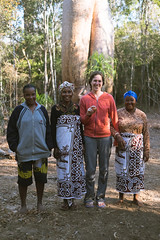
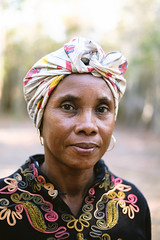

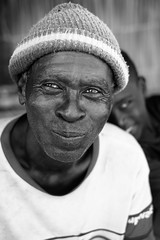
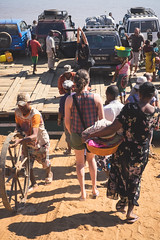
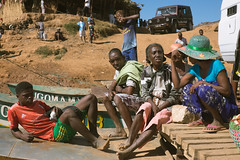
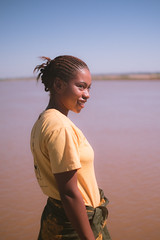
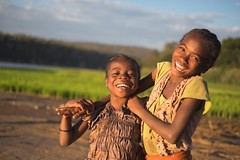

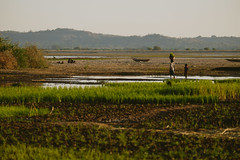
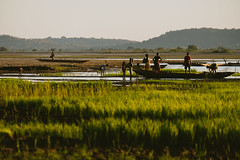

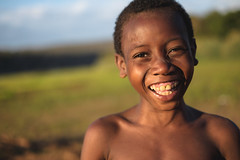
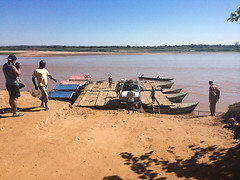
We had a funny incident at breakfast where they asked how I wanted my eggs done and I said boiled not even thinking about it. Everyone else had been getting them omelette style. Christian got his omelette within 5 minutes. My boiled egg was apparently an issue however. We waited 5, 10, 20 minutes! Claudia finally asked what was going on and it turned out they only have a big pot and they were boiling a lot of water for one little egg and they forgot to tend the fire. We laughed about this and I felt embarrassed for ordering such a thing. Christian had a funny idea of taking a picture with me, the one boiled egg, and the three cooks. Claudia thought it was funny and so did the cooks, so we had a little photoshoot with them.
We practiced our Malagasy with them, asking what were their names, telling them ours. They introduced themselves as “Madame” – Madame Marieti, Madame Hova, and Madame Vav. Madame means that you are married. I am Madame Laura then!
Our day today is all about car and ferry travel all the way to Bekopaka, where we will view another Unesco site – the petit and grand tsingy.
Even though it is an estimated 8 hour trip, it has proved interesting so far. Here are some things we have seen along the way:
– little towns and villages in the same Sakalava tribe / dry forest style that we saw in Anjajavy with stick sides and palm thatch roof
– Women with cassava on their face. They put it there as sunscreen and to help their skin stay young
– A man on a bike carrying a dead duck in his hand – have not seen that one in Portland yet!
– People staring at us as we go by, some waving, some children shouting vazaha which means foreigner
– Concrete tombs in the Sakalava style – these are the most permanent structures we see. Malagasy people have so many rituals and traditions around their ancestors.
– People walking, biking, and Zebu carting between towns
– An occasional taxi brusse (local bus) laden with people and objects strapped to the top
– Other SUVs like ours with tourists and guides inside.
– Rice farms
– The landscape turns from dry forest to wetter palms as we near water and then dry again
– Miles and miles of bumpy, potholed, twisted, rutted, red dry mud, rocks and sandy road! So bad that we average 25 km or 15 miles per hour! Rivu is an excellent driver tho.
– A stray dog by himself
– A Madagascar hoopoe – a bird with a cool crest, and a Madagascar Paradise Flycatcher – fun looong tail
– Rice bags and big trucks to take them to the cities
– Zebu herds and herders
– Areas where people are practicing slash and burn agriculture – the chief culprit of deforestation. Claudia disapproves. From what I read, the people doing it know better too but don’t see other options or are tied to the traditions of their families.
– a boy wearing an amulet. Mothers give this to their kids to ward away bad spirits from taking them
– Men and women dressed in the Sakalava tradition – with the lamba, or bright colored sarong type cloth. Women wear as a skirt or full dress. Men wear it around their shoulders and sleep on it. The saddest incident of the trip so far happened when we asked one teenage boy who was wearing a beautiful yellow lamba around his shoulders of we could take his picture. He looked embarrassed and did not want a picture. His kid brothers or cousins who were with him started begging – not for money but for water! Claudia explained that people living in the dry forests of the west of the country like this are the poorest people because they have to walk far just to get water. They don’t move to wetter places for many complicated reasons.
Around noon we reach the Tsiribihina river. The town on one side of the river is called Tsimafana, or “not hot”. The other side is called Belu sur Tsiribihina – it is the biggest town on the road from Morandava to Bekopaka.
We wandered about Tsimagana for a bit while waiting for the ferry. We saw two girls playing Tantara which means “story game”. It’s a lot like playing dolls – making up stories usually based on their every day lives. The difference is they use stones instead of dolls. And for a reason I did not catch they bang the stones together.
Many people also wanted to play “take my picture” with Christian and he was happy to oblige. First was Loansia, a little girl and next was Razon, an old man.
The ferry was quite interesting – would certainly not pass any sort of US safety standards but it still did the job! It’s basically two big canoe shaped boats joined in the middle with a wooden plank deck on top. The ramp to get the cars on was two saggy looking pieces of wood. Four SUVs squeeze on and then tourists and locals alike crowd around on the space that’s left – no railing or anything. It’s a calm river so there is no problem.
We ended up standing next to three beautiful 19 year old young women. One, Lia, really liked the take my picture game. They had been visiting relatives on one side of he river and were returning home.
There was also a funny old lady who wanted her picture taken and then demanded to see it even when her friends told her she needed to go.
I practiced my Spanish with some tourists from Spain.
The ferry ride took half an hour. We passed the ferry carrying local foot passengers. It was so full it almost looked sunk. This local ferry capsized recently – there were too many people and objects. It killed 60 people!
On the other side there were more begging children, which is always strange to see. A very tall tourist who knew Malagasy had a big throng of them around him. He was making them laugh and also telling them that they should not ask things from him, they should go to school and work to make money after.
The afternoon drive took 4 hours and there were hardly any villages. Just dry forest and grasslands. And the road got even worse! All in all we only went 145 total km but it took 7 hours in the car plus a half an hour ferry.
We had one more smaller river to cross – the Manambolo – before we reached Bekopaka. However, when we arrived at the river bank we found our that the ferry engine had died that afternoon!
Three men had the engine out on some blocks on the river bank, trying to get it to go. In the mean time, four men on each corner of the ferry were using long poles to push the ferry across. So we waited our turn and walked along the riverbank.
We immediately met the most insistent gang of children – they were used to interacting with tourists. Christian, who is so good with children, played take my picture with them, trying almost in vain to get them to stand in a line. Claudia helped out.
Claudia and I strolled out to the rice fields along the river and I saw close up what a rice plant looked like – I had never seen one in close range before. The rice comes from the top of the plant, like wheat. Didn’t know that!
The most sketchy part of the trip came next, sitting in the car going up the ramp into the ferry *from the water*. They didn’t want to land the ferry since it is harder to get off the bank by hand, hence the watery entrance. We had a strange entrance trajectory due to our third position on the ferry and I felt out wheels slipping slightly! Eek! But Rivu once again proved his awesome driving skills and got us safely on the boat.
We were sandwiched between two other cars and so couldn’t get out. I sat and enjoyed the Kilalaky music playing on the ferry radio which is fun danceable Malagasy music that even the group of American boys in the car next door couldn’t help seat dancing to. It was also interesting trying to watch the men pole the boat across.
Finally, Bekopaka! We drove up to our hotel for the next few days – Le Grande Hotel de Tsingy. It’s a super comfortable place that a Westerner like ourselves can relax at – strange to be out of Madagascar and into this place but still a relief.
Over dinner we learned that the waiters were studying tourism at school and this place was one of their internships. They were so cute, being so careful with pouring water and clearing plates etc.
Claudia told us about an interesting organization that she is a part of – Ecotanana. It’s an association of tour guides, hotels, and restaurants in Tana which practices and learns sustainable tourism together.